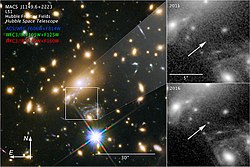| Observation data Epoch J2000.0 Equinox J2000.0 | |
|---|---|
| Constellation | Perseus |
| Right ascension | 04h 43m 21.37s [1] |
| Declination | +47° 21′ 25.9″ [1] |
| Apparent magnitude (V) | 6.3 - 16.9 [2] |
| Characteristics | |
| B−V color index | +1.0 [3] |
| V−R color index | +0.9 [3] |
| Variable type | dwarf nova & nova [1] |
| Astrometry | |
| Proper motion (μ) | RA: 0.193 [4] mas/yr Dec.: −1.749 [4] mas/yr |
| Parallax (π) | 0.2573±0.0516 mas [4] |
| Distance | 4161+2345 −440 [5] pc |
| Absolute magnitude (MV) | −10.1 (max) [6] |
| Other designations | |
| AAVSO 0435+47, V392 Per, Gaia DR2 254361745823908736, 2MASS J04432138+4721257 [7] | |
| Database references | |
| SIMBAD | data |
V392 Persei, also known as Nova Persei 2018, is a bright nova in the constellation Perseus discovered on April 29, 2018. It was previously known as a dwarf nova.





